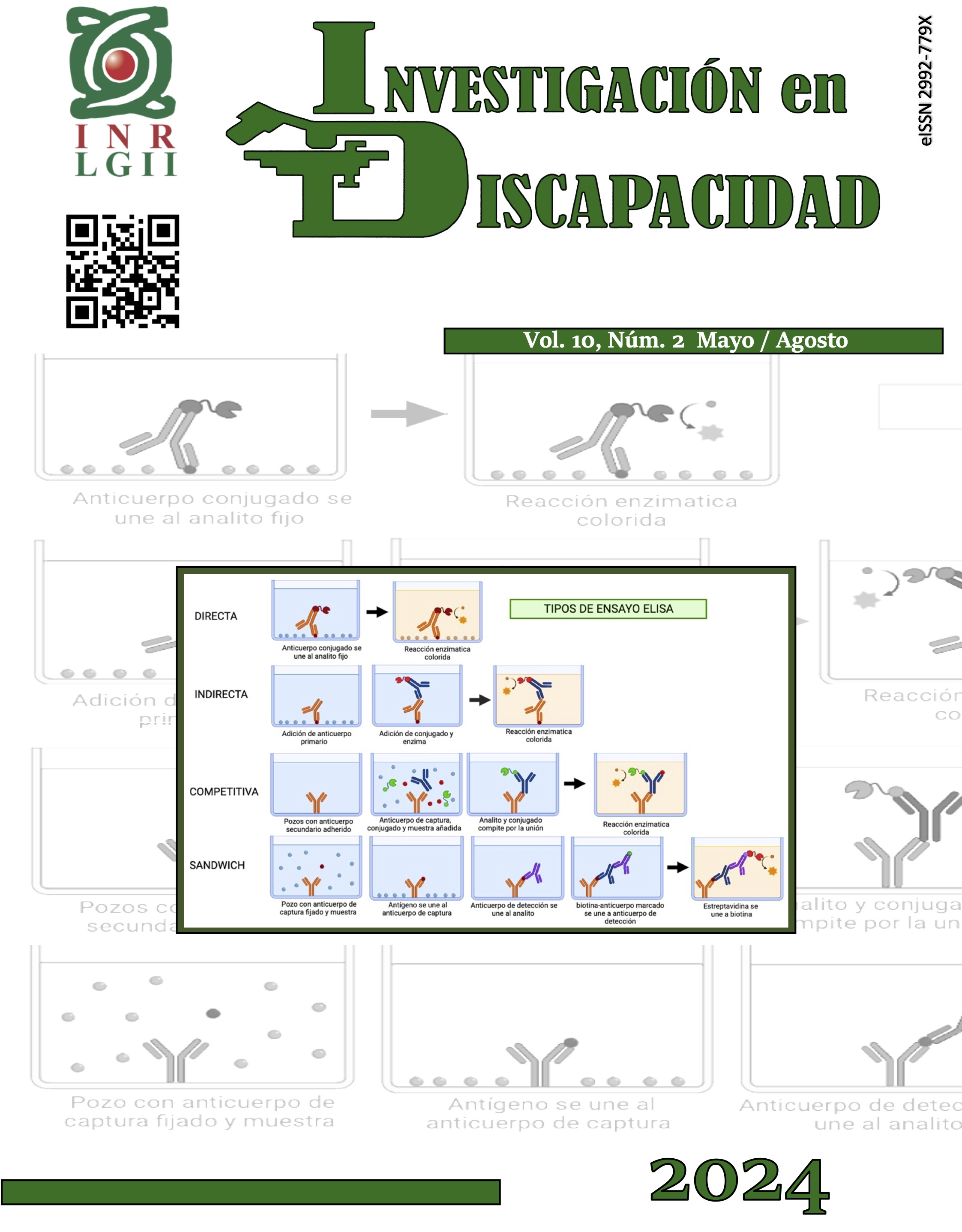Técnicas para la determinación de proteínas: inmunofluorescencia y ELISA
DOI:
https://doi.org/10.35366/116874Palabras clave:
ELISA, inmunofluorescencia, confocal, anticuerpo, antígenoResumen
Las técnicas inmunológicas que utilizan anticuerpos han sido muy empleadas desde su aparición, actualmente son herramientas elementales no sólo para la investigación básica y clínica, sino para el diagnóstico de muchas enfermedades. Esto se debe a su y especificidad y reproducibilidad hacía antígenos por parte de anticuerpos específicos obtenidos de diversas moléculas pequeñas y grandes, muchas de ellas proteínas. Las técnicas de tinción por inmunofluorescencia (IF) y de ensayos de inmunoabsorción ligado a enzimas (ELISA por sus siglas en inglés) son parte de estas técnicas importantes, por lo que entender sus tipos o variantes que existen y las diferencias entre estas técnicas es básico para utilizarlas adecuadamente y obtener el máximo provecho de cada una de ellas. Estas técnicas junto a la electroforesis de proteínas nos permiten identificar proteínas diferentes en una sola muestra, su localización en un tejido, su presencia o ausencia, también poca o mucha abundancia de la proteína en ese tejido o células. Aquí revisaremos los pasos generales de estas técnicas, sus aplicaciones y los detalles técnicos a considerar si vamos a empezar a trabajar con alguna de ellas.
##plugins.generic.pfl.publicationFactsTitle##
##plugins.generic.pfl.reviewerProfiles## N/D
##plugins.generic.pfl.authorStatements##
Indexado: {$indexList}
-
##plugins.generic.pfl.indexedList##
- ##plugins.generic.pfl.academicSociety##
- N/D
Citas
Hussaini HM, Seo B, Rich AM. Immunohistochemistry and Immunofluorescence. Methods Mol Biol. 2023; 2588: 439-450.
Wheatley SP, Wang YL. Indirect immunofluorescence microscopy in cultured cells. Methods Cell Biol. 1998; 57: 313-332.
Uniacke J, Colón-Ramos D, Zerges W. FISH and immunofluorescence staining in Chlamydomonas. Methods Mol Biol. 2011; 714: 15-29.
Huhn A, Nairn RC. A nuclear staining artefact in immunofluorescence. Clin Exp Immunol. 1967; 2 (6): 697-700.
ArosCJ.Indirectimmunofluorescenceoftissuesections. Methods Mol Biol. 2022; 2386: 17-26.
Mori H, Cardiff RD. Methods of Immunohistochemistry and immunofluorescence: converting invisible to visible. Methods Mol Biol. 2016; 1458: 1-12.
ImK,MareninovS,DiazMFP,YongWH.Anintroduction to performing immunofluorescence staining. Methods Mol Biol. 2019; 1897: 299-311.
Elsborg SH, Pedersen GA, Madsen MG, Keller AK, Norregaard R, Nejsum LN. Multiplex immunofluorescence staining of coverslip-mounted paraffin-embedded tissue sections. APMIS. 2023; 131 (8): 394-402.
Piña R, Santos-Díaz AI, Orta-Salazar E, Aguilar- Vazquez AR, Mantellero CA, Acosta-Galeana I, et al. Ten approaches that improve immunostaining: a review of the latest advances for the optimization of immunofluorescence. Int J Mol Sci. 2022; 23 (3): 1426.
Yao B, Liu F, Mo X, Liu Q, Ren Y. A filtration medium replacement method that increases the efficiency of immunofluorescence staining of oocytes. Biotech Histochem. 2023; 98 (7): 466-470.
Wang H, Matise MP. Immunofluorescence staining with frozen mouse or chick embryonic tissue sections. Methods Mol Biol. 2013; 1018: 175-188.
Sood A, Sui Y, McDonough E, Santamaría-Pang A, Al-Kofahi Y, Pang Z et al. Comparison of multiplexed immunofluorescence imaging to chromogenic immunohistochemistry of skin biomarkers in response to monkeypox virus infection. Viruses. 2020; 12 (8): 787.
Zhang H, Tan C, Shi X, Xu J. Impacts of autofluorescence on fluorescence based techniques to study microglia. BMC Neurosci. 2022; 23 (1): 21.
Donaldson JG. Immunofluorescence staining. Curr Protoc Cell Biol. 2001; 4: 4.3.
Webb DJ, Brown CM. Epi-fluorescence microscopy. Methods Mol Biol. 2013; 931: 29-59.
Duo-QuanW,Lin-HuaT,Zhen-ChengG,XiangZ,Man- Ni Y. Application of the indirect fluorescent antibody assay in the study of malaria infection in the Yangtze River Three Gorges Reservoir, China. Malar J. 2009; 8: 199.
Hopp AK, Hottiger MO. Investigation of mitochondrial ADP-Ribosylation via immunofluorescence. Methods Mol Biol. 2021; 2276: 165-171.
Riris S, Cawood S, Gui L, Serhal P, Homer HA. Immunofluorescence staining of spindles, chromosomes, and kinetochores in human oocytes. Methods Mol Biol. 2013; 957: 179-187.
Schoenfeld L, Appl B, Pagerols-Raluy L, Heuer A, Reinshagen K, Boettcher M. Immunofluorescence imaging of neutrophil extracellular traps in human and mouse tissues. J Vis Exp. 2023; (198). doi: 10.3791/65272. Erratum in: J Vis Exp. 2023; (199).
Parra-Medina R, Morales SD. Diagnostic utility of epithelial and melanocitic markers with double sequential immunohistochemical staining in differentiating melanoma in situ from invasive melanoma. Ann Diagn Pathol. 2017; 26: 70-74.
Cesare AJ, Heaphy CM, O’Sullivan RJ. Visualization of telomere integrity and function in vitro and in vivo using immunofluorescence techniques. Curr Protoc Cytom. 2015; 73: 12.40.1-12.40.31.
Wong A, Cianciolo RE. Comparison of immunohistochemistry and immunofluorescence
techniques using anti-lambda light chain antibodies for identification of immune complex deposits in canine renal biopsies. J Vet Diagn Invest. 2018; 30 (5): 721-727.
Aydin S. A short history, principles, and types of ELISA, and our laboratory experience with peptide/protein analyses using ELISA. Peptides. 2015; 72: 4-15.
PangB,ZhaoC,LiL,SongX,XuK,WangJetal. Development of a low-cost paper-based ELISA method for rapid Escherichia coli O157:H7 detection. Anal Biochem. 2018; 542: 58-62.
Knight AR, Taylor EL, Lukaszewski R, Jensen KT, Jones HE, Carré JE et al. A high-sensitivity electrochemiluminescence-based ELISA for the measurement of the oxidative stress biomarker, 3-nitrotyrosine, in human blood serum and cells. Free Radic Biol Med. 2018; 120: 246-254.
Zhao Q, Lu D, Zhang G, Zhang D, Shi X. Recent improvements in enzyme-linked immunosorbent assays based on nanomaterials. Talanta. 2021; 223(Pt 1): 121722.
Engvall E. Perspective on the historical note on EIA/ ELISA by Dr. R.M. Lequin. Clin Chem. 2005; 51 (12): 2225.
Alhajj M, Zubair M, Farhana A. Enzyme linked immunosorbent assay, in StatPearls. 2023: treasure island (FL) ineligible companies. Disclosure: muhammad zubair declares no relevant financial relationships with ineligible companies. Disclosure: Aisha Farhana declares no relevant financial relationships with ineligible companies.
Avrameas S. Coupling of enzymes to proteins with glutaraldehyde. Use of the conjugates for the detection of antigens and antibodies. Immunochemistry. 1969; 6 (1): 43-52.
Voller A, Bidwell D, Huldt G, Engvall E. A microplate method of enzyme-linked immunosorbent assay and its application to malaria. Bull World Health Organ. 1974; 51 (2): 209-211.
Voller A. The enzyme-linked immunosorbent assay (ELISA) (theory, technique and applications). Ric Clin Lab. 1978; 8 (4): 289-298.
Hornbeck PV. Enzyme-Linked Immunosorbent Assays. Curr Protoc Immunol. 2015; 110: 2.1.1-2.1.23.
Hayrapetyan H, Tran T, Tellez-Corrales E, Madiraju C. Enzyme-linked immunosorbent assay: types and applications. Methods Mol Biol. 2023; 2612: 1-17.
Bayer PM, Fabian B, Hubl W. Immunofluorescence assays (IFA) and enzyme-linked immunosorbent assays (ELISA) in autoimmune disease diagnostics--technique, benefits, limitations and applications. Scand J Clin Lab Invest Suppl. 2001; 235: 68-76.
Toh SY, Citartan M, Gopinath SC, Tang TH. Aptamers as a replacement for antibodies in enzyme-linked immunosorbent assay. Biosens Bioelectron. 2015; 64: 392-403.
Tabatabaei MS, Ahmed M. Enzyme-linked immunosorbent assay (ELISA). Methods Mol Biol. 2022; 2508: 115-134.
Jaschke PR. Simulated sandwich enzyme-linked immunosorbent assay for a cost-effective investigation of natural and engineered cellular signaling pathways.
Biochem Mol Biol Educ. 2020; 48 (1): 67-73.
Sue MJ, Yeap SK, Omar AR, Tan SW. Application of PCR-ELISA in molecular diagnosis. Biomed Res Int.
Sakamoto S, Putalun W, Vimolmangkang S, Phoolcharoen W, Shoyama Y, Tanaka H, Morimoto S. Enzyme-linked immunosorbent assay for the quantitative/qualitative analysis of plant secondary metabolites. J Nat Med. 2018; 72 (1): 32-42.
Lombard M, Precausta P, Tixier G, Chomel B. The application of the ELISA technique to the serology of chlamydiosis in goats: statistical evaluation of a method. J Biol Stand. 1987; 15 (4): 293-304.
Descargas
Publicado
Cómo citar
Número
Sección
Licencia
Derechos de autor 2024 Instituto Nacional de Rehabilitación Luis Guillermo Ibarra Ibarra

Esta obra está bajo una licencia internacional Creative Commons Atribución 4.0.
© Instituto Nacional de Rehabilitación Luis Guillermo Ibarra Ibarra under a Creative Commons Attribution 4.0 International (CC BY 4.0) license which allows to reproduce and modify the content if appropiate recognition to the original source is given.




